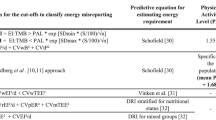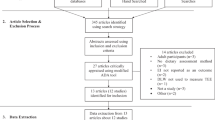Abstract
Background/Objectives:
Validation-study data were analyzed to investigate the effect of retention interval (time between the to-be-reported meal and interview) on accuracy of children's school-breakfast reports and school-lunch reports in 24-h recalls, and to compare accuracy of children's school-breakfast reports for two breakfast locations (classroom; cafeteria).
Subjects/Methods:
Each of 374 fourth-grade children was interviewed to obtain a 24-h recall using one of six conditions from crossing two target periods (prior 24 h; previous day) with three interview times (morning; afternoon; evening). Each condition had 62 or 64 children (half boys). A recall's target period included one school breakfast and one school lunch, for which the child had been observed. Food-item variables (observed number; reported number; omission rate; intrusion rate) and energy variables (observed; reported; report rate; correspondence rate; inflation ratio) were calculated for each child for school breakfast and school lunch separately.
Results:
Accuracy for school-breakfast reports and school-lunch reports was inversely related to retention interval. Specifically, as indicated by smaller omission rates, smaller intrusion rates, larger correspondence rates and smaller inflation ratios, accuracy for school-breakfast reports was best for prior-24-h recalls in the morning, and accuracy for school-lunch reports was best for prior-24-h recalls in the afternoon. For neither school meal was a significant sex effect found for any variable. For school-breakfast reports, there was no significant school-breakfast location effect for any variable.
Conclusions:
By shortening the retention interval, accuracy can be improved for school-breakfast reports and school-lunch reports in children's 24-h recalls.
This is a preview of subscription content, access via your institution
Access options
Subscribe to this journal
Receive 12 print issues and online access
$259.00 per year
only $21.58 per issue
Buy this article
- Purchase on Springer Link
- Instant access to full article PDF
Prices may be subject to local taxes which are calculated during checkout


Similar content being viewed by others
References
Baglio ML, Baxter SD, Guinn CH, Thompson WO, Shaffer NM, Frye FHA (2004). Assessment of interobserver reliability in nutrition studies that use direct observation of school meals. J Am Diet Assoc 104, 1385–1393.
Baranowski T, Dworkin R, Henske JC, Clearman DR, Dunn JK, Nader PR et al. (1986). The accuracy of children's self-reports of diet: Family Health Project. J Am Diet Assoc 86, 1381–1385.
Baranowski T, Smith M, Baranowski J, Wang DT, Doyle C, Lin LS et al. (1997). Low validity of a seven-item fruit and vegetable food frequency questionnaire among third-grade students. J Am Diet Assoc 97, 66–68.
Baxter SD (2009). Cognitive processes in children's dietary recalls: insight from methodological validation studies. Eur J Clin Nutr 63 (Suppl), S19–S32.
Baxter SD, Guinn CH, Royer JA, Hardin JW, Mackelprang AJ, Smith AF (submitted). Shortening the retention interval of 24-hour dietary recalls increases fourth-grade children's accuracy for reporting energy and macronutrient intake at school meals.
Baxter SD, Hardin JW, Guinn CH, Royer JA, Mackelprang AJ, Smith AF (2009). Fourth-grade children's dietary recall accuracy is influenced by retention interval (target period and interview time). J Am Diet Assoc 109, 846–856.
Baxter SD, Smith AF, Guinn CH, Thompson WO, Litaker MS, Baglio ML et al. (2003a). Interview format influences the accuracy of children's dietary recalls validated with observations. Nutr Res 23, 1537–1546.
Baxter SD, Smith AF, Hardin JW, Nichols MN (2007a). Conclusions about children's reporting accuracy for energy and macronutrients over multiple interviews depend on the analytic approach for comparing reported information to reference information. J Am Diet Assoc 107, 595–604.
Baxter SD, Smith AF, Hardin JW, Nichols MN (2007b). Conventional energy and macronutrient variables distort the accuracy of children's dietary reports: illustrative data from a validation study of effect of order prompts. Prev Med 44, 34–41.
Baxter SD, Smith AF, Litaker MS, Guinn CH, Nichols MN, Miller PH et al. (2006). Body mass index, sex, interview protocol, and children′s accuracy for reporting kilocalories observed eaten at school meals. J Am Diet Assoc 106, 1656–1662.
Baxter SD, Smith AF, Litaker MS, Guinn CH, Shaffer NM, Baglio ML et al. (2004). Recency affects reporting accuracy of children's dietary recalls. Ann Epidemiol 14, 385–390.
Baxter SD, Thompson WO, Davis HC (2001). Trading of food during school lunch by first- and fourth-grade children. Nutr Res 21, 499–503.
Baxter SD, Thompson WO, Litaker MS, Frye FHA, Guinn CH (2002). Low accuracy and low consistency of fourth-graders’ school breakfast and school lunch recalls. J Am Diet Assoc 102, 386–395.
Baxter SD, Thompson WO, Litaker MS, Guinn CH, Frye FHA, Baglio ML et al. (2003b). Accuracy of fourth-graders’ dietary recalls of school breakfast and school lunch validated with observations: In-person versus telephone interviews. J Nutr Educ Behav 35, 124–134.
Baxter SD, Thompson WO, Smith AF, Litaker MS, Yin Z, Frye FHA et al. (2003c). Reverse versus forward order reporting and the accuracy of fourth-graders’ recalls of school breakfast and school lunch. Prev Med 36, 601–614.
Bernstein LS, McLaughlin JE, Crepinsek MK, Daft LM (2004). Evaluation of the School Breakfast Program Pilot Project: Final Report. Nutrition Assistance Program Report Series, No. CN-04-SBP, Project Officer: Anita Singh. Alexandria, VA. http://www.fns.usda.gov/oane/MENU/published/CNP/FILES/SBPPFinal.pdf (Accessed 7 July 2009).
Buzzard M (1998). 24-hour dietary recall and food record methods. In: Willett W (ed). Nutritional Epidemiology 2nd edn. Oxford University Press: New York, NY. pp 50–73.
Crawford PB, Obarzanek E, Morrison J, Sabry ZI (1994). Comparative advantage of 3-day food records over 24-hour recall and 5-day food frequency validated by observation of 9- and 10-year-old girls. J Am Diet Assoc 94, 626–630.
Crepinsek MK, Singh A, Bernstein LS, McLaughlin JE (2006). Dietary effects of universal-free school breakfast: Findings from the Evaluation of the School Breakfast Program Pilot Project. J Am Diet Assoc 106, 1796–1803.
Domel SB, Baranowski T, Davis HC, Leonard SB, Riley P, Baranowski J (1994). Fruit and vegetable food frequencies by fourth and fifth grade students: Validity and reliability. J Am Coll Nutr 13, 33–39.
Gordon AR, Cohen R, Crepinsek MK, Fox MK, Hall J, Zeidman E (2009a). The Third School Nutrition Dietary Assessment Study: Background and study design. J Am Diet Assoc 109 (Suppl), S20–S30.
Gordon AR, Crepinsek MK, Briefel RR, Clark MA, Fox MK (2009b). The Third School Nutrition Dietary Assessment Study: Summary and implications. J Am Diet Assoc 109 (Suppl), S129–S135.
Himes JH, Ring K, Gittelsohn J, Cunningham-Sabo L, Weber J, Thompson JK et al. (2003). Impact of the Pathways intervention on dietary intakes of American Indian schoolchildren. Prev Med 37 (Suppl), S55–S61.
Luepker RV, Perry CL, McKinlay SM, Nader PR, Parcel GS, Stone EJ et al. (1996). Outcomes of a field trial to improve children's dietary patterns and physical activity: The Child and Adolescent Trial for Cardiovascular Health (CATCH). JAMA 275, 768–776.
Mertz W (1992). Food intake measurements: Is there a “gold standard”? J Am Diet Assoc 92, 1463–1465.
Moore HJ, Ells LJ, McLure SA, Crooks S, Cumbor D, Summerbell CD et al. (2008). The development and evaluation of a novel computer program to assess previous-day dietary and physical activity behaviours in school children: The Synchronised Nutrition and Activity Program™ (SNAP™). Br J Nutr 99, 1266–1274.
Ralston K, Newman C, Clauson A, Guthrie J, Buzby J (2008). The National School Lunch Program: Background, Trends, and Issues. Economic Research Report No. EER-61: US Department of Agriculture, Economic Research Service. http://www.ers.usda.gov/Publications/ERR61/ (Accessed 7 July 2009).
Reynolds LA, Johnson SB, Silverstein J (1990). Assessing daily diabetes management by 24-hour recall interview: The validity of children's reports. J Pediatr Psychol 15, 493–509.
Samuelson G (1970). An epidemiological study of child health and nutrition in a northern Swedish county. II. Methodological study of the recall technique. Nutr Metab 12, 321–340.
Shaffer NM, Baxter SD, Thompson WO, Baglio ML, Guinn CH, Frye FHA (2004). Quality control for interviews to obtain dietary recalls from children for research studies. J Am Diet Assoc 104, 1577–1585.
Simons-Morton BG, Baranowski T (1991). Observation in assessment of children's dietary practices. J Sch Health 61, 204–207.
Smith AF (1991). Cognitive Processes in Long-term Dietary Recall. National Center for Health Statistics, Vital and Health Statistics: Hyattsville, MD. Series 6, No. 4.
Smith AF, Baxter SD, Hardin JW, Nichols MN (2007). Conventional analyses of data from dietary validation studies may misestimate reporting accuracy: illustration from a study of the effect of interview modality on children's reporting accuracy. Public Health Nutr 10, 1247–1256.
Smith AF, Jobe JB, Mingay DJ (1991). Retrieval from memory of dietary information. Appl Cognit Psychol 5, 269–296.
Story M, Kaphingst KM, Robinson-O’Brien R, Glanz K (2008). Creating healthy food and eating environments: Policy and environmental approaches. Annu Rev Public Health 29, 253–272.
Story M, Snyder MP, Anliker J, Weber JL, Cunningham-Sabo L, Stone EJ et al. (2003). Changes in the nutrient content of school lunches: results from the Pathways study. Prev Med 37 (Suppl), S35–S45.
Tapper K, Murphy S, Moore L, Lynch R, Clark R (2007). Evaluating the free school breakfast initiative in Wales: methodological issues. Br Food J 109, 206–215.
Todd KS, Kretsch MJ (1986). Accuracy of the self-reported dietary recall of new immigrant and refugee children. Nutr Res 6, 1031–1043.
Acknowledgements
This research was supported by the National Heart, Lung and Blood Institute of the National Institutes of Health (grant R01 HL074358 to SD Baxter). The content of this paper is solely the responsibility of the authors and does not necessarily represent the official views of the National Heart, Lung and Blood Institute or the National Institutes of Health. The authors appreciate the cooperation of children, faculty and staff of elementary schools, and staff of Student Nutrition Services, of the Richland One School District (Columbia, SC, USA). The authors give tribute to Amy F Joye, MS, RD; Amy was Project Director for this grant until she suffered severe brain damage due to a medical tragedy at age 36. The Amy Joye Memorial Research Fund has been established through the American Dietetic Association Foundation to award nutrition research grants on an annual basis in Amy's memory.
Author information
Authors and Affiliations
Corresponding author
Rights and permissions
About this article
Cite this article
Baxter, S., Guinn, C., Royer, J. et al. Accuracy of children's school-breakfast reports and school-lunch reports (in 24-h dietary recalls) differs by retention interval. Eur J Clin Nutr 63, 1394–1403 (2009). https://doi.org/10.1038/ejcn.2009.107
Received:
Revised:
Accepted:
Published:
Issue Date:
DOI: https://doi.org/10.1038/ejcn.2009.107
Keywords
This article is cited by
-
Schriftliche Befragungen von Grundschulkindern
Prävention und Gesundheitsförderung (2018)
-
Feasibility of 2 × 24-h dietary recalls combined with a food-recording booklet, using EPIC-Soft, among schoolchildren
European Journal of Clinical Nutrition (2011)



